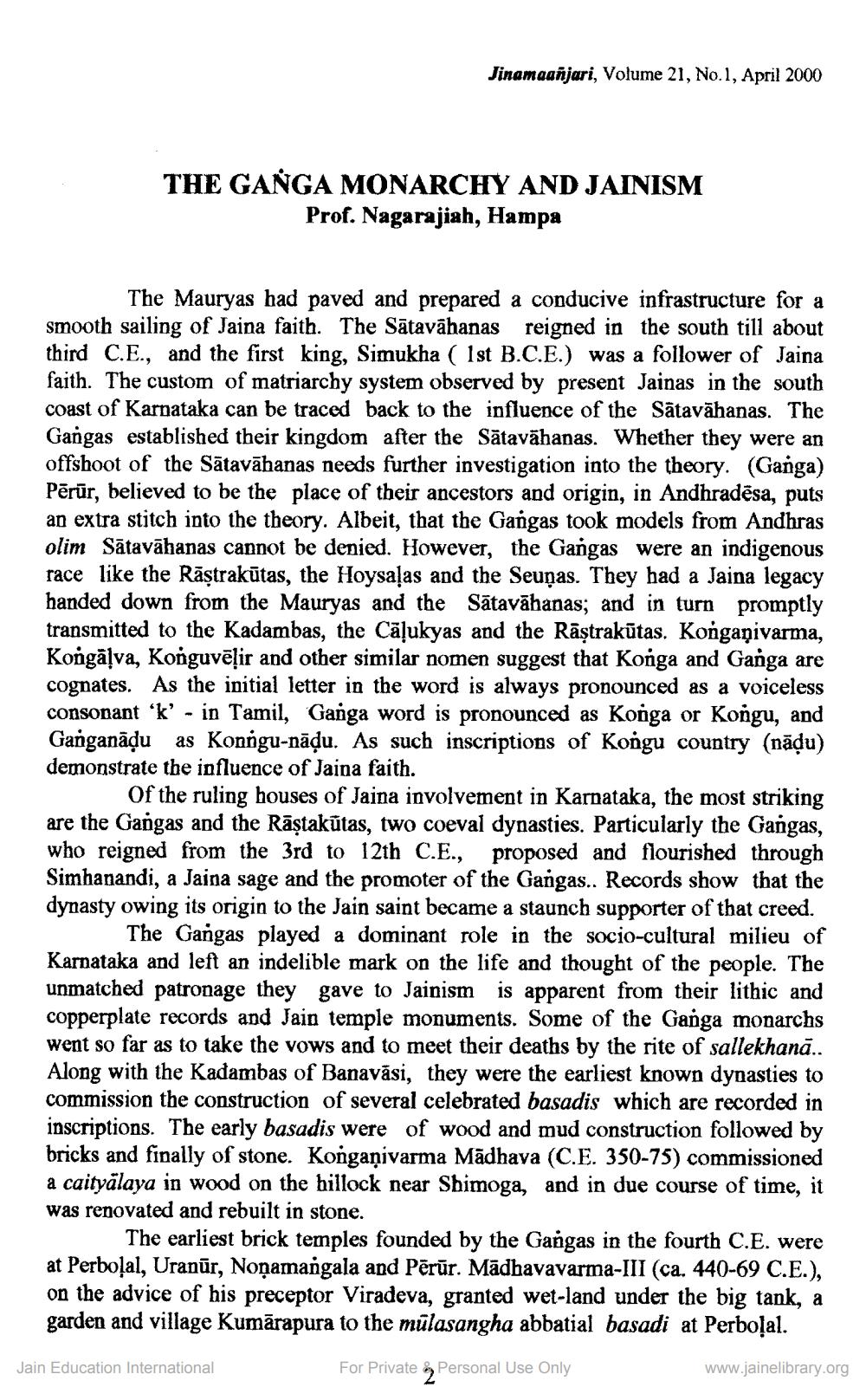Book Title: Jinamanjari 2000 04 No 21 Author(s): Jinamanjari Publisher: Canada Bramhi Jain Society Publication View full book textPage 5
________________ Jinamaanjari, Volume 21, No. 1, April 2000 THE GANGA MONARCHY AND JAINISM Prof. Nagarajiah, Hampa The Mauryas had paved and prepared a conducive infrastructure for a smooth sailing of Jaina faith. The Sātavāhanas reigned in the south till about third C.E., and the first king, Simukha ( 1st B.C.E.) was a follower of Jaina faith. The custom of matriarchy system observed by present Jainas in the south coast of Karnataka can be traced back to the influence of the Sātavāhanas. The Gangas established their kingdom after the Sātavāhanas. Whether they were an offshoot of the Sātavāhanas needs further investigation into the theory. (Ganga) Pērür, believed to be the place of their ancestors and origin, in Andhradēsa, puts an extra stitch into the theory. Albeit, that the Gangas took models from Andhras olim Sātavāhanas cannot be denied. However, the Gangas were an indigenous race like the Rāştrakūtas, the Hoysaļas and the Seuņas. They had a Jaina legacy handed down from the Mauryas and the Sātavāhanas; and in turn promptly transmitted to the Kadambas, the Cāļukyas and the Rāştrakūtas. Kongaộivarma, Kongāļva, Konguvēļir and other similar nomen suggest that Konga and Ganga are cognates. As the initial letter in the word is always pronounced as a voiceless consonant 'k' - in Tamil, Ganga word is pronounced as Konga or Kongu, and Ganganādu as Konngu-nāļu. As such inscriptions of Kongu country (nādu) demonstrate the influence of Jaina faith. Of the ruling houses of Jaina involvement in Karnataka, the most striking are the Gangas and the Rāstakūtas, two coeval dynasties. Particularly the Gangas. who reigned from the 3rd to 12th C.E., proposed and flourished through Simhanandi, a Jaina sage and the promoter of the Gangas.. Records show that the dynasty owing its origin to the Jain saint became a staunch supporter of that creed. The Gangas played a dominant role in the socio-cultural milieu of Karnataka and left an indelible mark on the life and thought of the people. The unmatched patronage they gave to Jainism is apparent from their lithic and copperplate records and Jain temple monuments. Some of the Ganga monarchs went so far as to take the vows and to meet their deaths by the rite of sallekhanā.. Along with the Kadambas of Banavāsi, they were the earliest known dynasties to commission the construction of several celebrated basadis which are recorded in inscriptions. The early basadis were of wood and mud construction followed by bricks and finally of stone. Konganivarma Madhava (C.E. 350-75) com a caityālaya in wood on the hillock near Shimoga, and in due course of time, it was renovated and rebuilt in stone. The earliest brick temples founded by the Gangas in the fourth C.E. were at Perboļal, Uranūr, Noņamangala and Pērür. Madhavavarma-III (ca. 440-69 C.E.), on the advice of his preceptor Viradeva, granted wet-land under the big tank, a garden and village Kumārapura to the mulasangha abbatial basadi at Perboļal. Jain Education International For Private 2 Personal Use Only www.jainelibrary.orgPage Navigation
1 ... 3 4 5 6 7 8 9 10 11 12 13 14 15 16 17 18 19 20 21 22 23 24 25 26 27 28 29 30 31 32 33 34 35 36 37 38 39 40 41 42 43 44 45 46 47 48 49 50 51 52 ... 88
